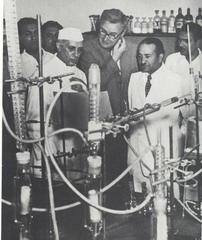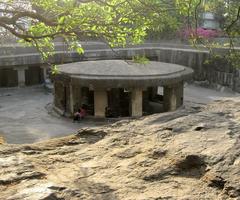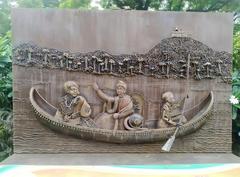Aga Khan Palace Pune: Visiting Hours, Tickets, and History Guide
Date: 14/06/2025
Introduction
Nestled in Pune, the Aga Khan Palace is a landmark of philanthropic vision, architectural brilliance, and a crucial chapter in India’s freedom movement. Built in 1892 by Sultan Muhammed Shah Aga Khan III as a famine relief effort, the palace later became a site of national significance, serving as a place of internment for Mahatma Gandhi and other leaders during the Quit India Movement of 1942. Today, the palace stands as both a memorial and an educational museum, offering visitors a unique opportunity to explore India’s past amid serene gardens and grand architecture (Native Planet; Tour My India; Culture and Heritage; Thrillophilia).
Table of Contents
- Introduction
- Historical Background and Significance
- Visiting Information
- Visuals and Media
- FAQs
- Conclusion
- References
Historical Background and Significance
Origins and Charitable Purpose
The Aga Khan Palace was commissioned in 1892 by Sultan Muhammed Shah Aga Khan III to create employment for those affected by famine in Maharashtra. The construction engaged around 1,000 workers over five years, costing Rs 1.2 million—a remarkable act of charity and social upliftment at the time (Native Planet).
Architectural Features
Sprawled across 19 acres, the palace exhibits a harmonious blend of Indo-Saracenic, Italianate Renaissance, and Mughal styles. Key features include Italian arches, grand halls, wide verandahs, and beautifully landscaped gardens along the Mula River. The interiors showcase mahogany doors, mosaic flooring, and ornamental ironwork, reflecting opulence and durability (Tour My India).
Role in India’s Freedom Struggle
During the Quit India Movement in 1942, British authorities detained Mahatma Gandhi, Kasturba Gandhi, Mahadev Desai, and others at the palace. Both Kasturba Gandhi and Mahadev Desai passed away during this period, making the palace a poignant symbol of sacrifice (Native Planet; Culture and Heritage).
Memorials and Museum
The palace houses the samadhis (memorials) of Kasturba Gandhi and Mahadev Desai, as well as a memorial containing a portion of Mahatma Gandhi’s ashes. The on-site museum showcases possessions, photographs, and artifacts associated with Gandhi and the freedom movement, offering profound insight into India’s history.
Recognition and Preservation
In 1969, Aga Khan IV donated the palace to the people of India, and it was later declared a monument of national importance by the Archaeological Survey of India in 2003 (Tour My India). Ongoing restoration ensures that the palace remains a preserved heritage site.
Cultural Impact and Legacy
The palace continues to be a center for Gandhian philosophy, hosting events on significant national dates and providing a platform for khadi (hand-spun cloth) promotion. Its charitable legacy and historical resonance make it a vital cultural landmark in Pune.
Visiting Information
Visiting Hours
- Open: Daily, 9:00 AM – 5:30 PM
- Closed: Certain national holidays (confirm in advance with official sources or local tourism offices)
Ticket Prices
- Indian Citizens: INR 25
- Foreign Nationals: INR 200–300 (varies slightly by source; check at entry)
- Children (under 15): Free
- Purchase: Tickets are available at the entrance; online booking is generally not available as of June 2024 (Thrillophilia)
Accessibility & Facilities
- Wheelchair Access: Ramps at main entry points, accessible restrooms; some upper floors may be less accessible in this historic building.
- Facilities: Clean toilets, shaded seating in gardens, drinking water. Food is not allowed inside, but cafes are nearby.
Travel Tips and Best Time to Visit
- Best Time: December–February (pleasant weather); early mornings or late afternoons for fewer crowds and better lighting.
- Dress Code: Modest attire, especially near memorials.
- Footwear: Comfortable walking shoes recommended.
- Photography: Permitted in gardens and most areas; flash and videography may be restricted inside the museum.
- Conduct: Maintain silence in memorial areas and avoid littering.
How to Reach
- Address: Nagar Road, Samrat Ashok Road, Pune, Maharashtra 411006, India
- Distance: 4–7 km from Pune city center, 5 km from Pune International Airport, 4 km from Pune Railway Station.
- Transport: Taxi, auto-rickshaw, or public bus; parking available.
Guided Tours & Special Events
- Guided Tours: Available on-site for a nominal fee; inquire at the entrance.
- Annual Events: Gandhi Jayanti (Oct 2), Martyr’s Day (Jan 30), Kasturba Gandhi death anniversary (Feb 22), Independence and Republic Days—featuring commemorations and public gatherings.
Nearby Attractions
- Shaniwar Wada: 3 km, historic fort.
- Osho Ashram & Teerth Park: 3–4 km, meditation and wellness.
- Bund Garden: 5.6 km, riverside park.
- Pataleshwar Cave Temple, Raja Dinkar Kelkar Museum: Within 5 km, for a broader cultural tour.
Visuals and Media
Visitors can find high-quality images and virtual tours of Aga Khan Palace on official tourism portals and the Gandhi Memorial Society. Online galleries provide a preview of the palace’s architecture, gardens, and memorials, with alt text such as “Aga Khan Palace main facade under blue sky” for accessibility.
Frequently Asked Questions (FAQ)
Q: What are the Aga Khan Palace visiting hours?
A: 9:00 AM to 5:30 PM daily; closed on some national holidays.
Q: How do I buy tickets?
A: Tickets are purchased at the entrance; online booking is typically not available.
Q: Is the palace wheelchair accessible?
A: Yes, main areas are accessible via ramps; some historic sections may be limited.
Q: Can I take photos inside?
A: Photography is allowed in most areas, but flash and video may be restricted inside the museum.
Q: When is the best time to visit?
A: Winter months (December–February) offer pleasant weather and thinner crowds.
Conclusion
The Aga Khan Palace is an essential stop for anyone exploring Pune’s historical and cultural landscape. Its architectural splendor, poignant memorials, and ongoing cultural activities make it a living monument to India’s struggle for freedom and Gandhian ideals. Whether you come to reflect, learn, or simply enjoy its serene gardens, the palace offers a meaningful and memorable experience.
For the latest updates on visiting hours, tickets, and events, check with local tourism offices or the Gandhi Memorial Society. For more travel guides, download the Audiala app and follow us on social media.




